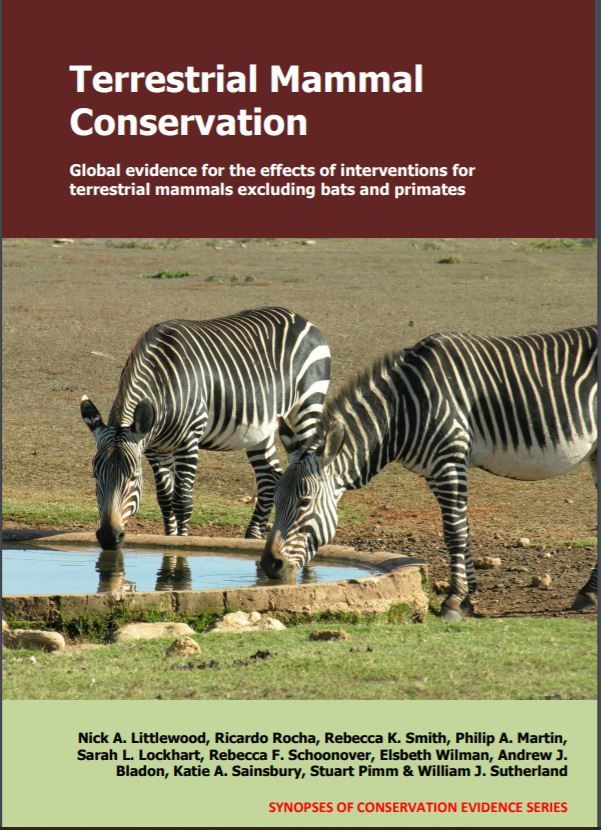Mammals have long inspired us to observe and care for the world around us, even becoming symbols of conservation such as the WWF Panda. The last few decades have seen range reductions and population declines for many mammal species due to overexploitation, pollution and habitat loss, amongst other reasons. Figures suggest that at least one-fifth of all mammal species are now threatened with extinction in the wild. Many are fighting to protect these iconic species, but how much do we actually know about how best to conserve them?
Reading all of the available literature on mammal conservation would be impossible. To help conservationists overcome this obstacle, the Conservation Evidence project based at the University of Cambridge summarises all the evidence on management actions you can take to conserve a given habitat or species. This is presented in plain English and available free on the website and to download. To date, the team have scanned over one million journal papers, with over 345,000 of these in non-English languages, summarising 6,616 studies on 2,105 management actions.
This June sees the long-awaited publication of the mammal synopsis. This synopsis covers all terrestrial mammals excluding bats and primates that have their own synopses. Covering threat topics from human-wildlife conflict to development, the team behind this synopsis scanned papers from all major and specialised conservation journals in three languages.
They summarised the evidence for 294 management actions from 935 studies. The studies included range from standard practice such as setting hunting quotas to protect populations, to the truly bizarre such as parachuting beavers to translocate them to a remote terrain (Heter 1950)!
People are often surprised to learn that evidence is often not used at all in conservation management decisions. This is often not due to unwillingness or complacency, but down to many factors such as limited access to studies that are behind pay-walls, confusing jargon and technical language, uncertainty in results, and a lack of skills to incorporate evidence into complicated decisions. Conservation Evidence aims to break down these barriers to enable conservationists to easily include evidence in their decisions, not only by providing the summarised evidence, but also by delivering the tools and skills necessary to interpret and use it.
In addition, many actions may seem like common sense, causing people to not consult the evidence base before employing them. For example, a study from India monitored the frequency of leopard attacks after translocation away from human settlements, it was assumed this action would reduce the number of attacks (Arthreya et al. 2011). Instead, the translocation was shown to cause a significant increase in the frequency and fatality in livestock and human attacks. This was thought to be due to them being moved into already occupied territories as well as the stress of translocation.
Other problems arise because actions may simply not give the desired outcome. For example, many studies in the mammal synopsis looked at road underpasses, culverts and nest boxes. However, these studies mostly only measure usage and not effects on population levels, so it can’t be known if the desired effect is really happening.
The mammal synopsis represents the largest collection of evidence gathered on ways to conserve mammal species. Despite this, for 64 out of the 294 management actions there was no evidence found. These were management actions that are routinely carried out, for example, there were no studies investigating the effects of coppicing trees which is a method often used to create beneficial habitats for dormice in the UK. These gaps highlight the need to further study and monitor the impact of actions being taken. In this way the evidence base can be continually updated to expand our knowledge of the effectiveness of management actions. This can be best achieved with the help of everyone who works with and studies mammals.
Written by Harriet Downey, Postdoctoral Researcher, Conservation Evidence, University of Cambridge. Email: hd438@cam.ac.uk
References
Athreya V., Odden M., Linnel J. & Karanth U. (2011) Translocation as a tool for mitigating conflict with leopards in human dominated landscapes of India. Conservation Biology, 25, 133–141.
Heter E.W. (1950) Transplanting beavers by airplane and parachute. The Journal of Wildlife Management, 14, 143–147.
Littlewood, N.A., Rocha, R., Smith, R.K., Martin, P.A., Lockhart, S.L., Schoonover, R.F., Wilman, E., Bladon, A.J., Sainsbury, K.A., Pimm S. and Sutherland, W.J. (2020) Terrestrial Mammal Conservation: Global Evidence for the Effects of Interventions for terrestrial mammals excluding bats and primates. Synopses of Conservation Evidence Series. University of Cambridge, Cambridge, UK.

